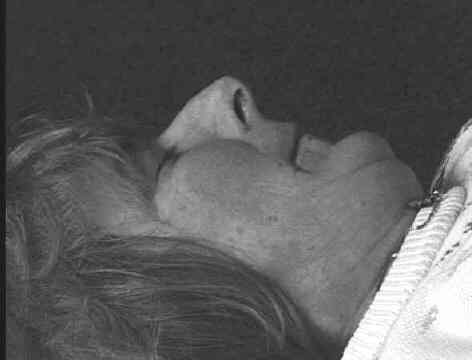Dancing Silence: Traces

|
Dancing Silence: Traces |
 |
traces engages with community movement sessions held since 1998 in Briton Ferry and Pontardawe Arts Centre, Wales. A group of users of the mental health day care services and other members of the community meet weekly with dance leader Petra Kuppers for 'Dance with a Difference' sessions.
The sessions use bodywork to foster well-being and movement experience. Each session consists of relaxation and visualisation exercises, and the creation of improvised dances.
traces uses video and photography by The Olimpias to re-create part of the session experience. In a video installation, huge images of the participants' concentrated faces and bodies surround a platform which invites the spectator to enter physically, to move from watcher to witness. The living performance traces in these images provide a counterpoint to many traditional representations of people in mental health settings, which focused on loss of control and chaos. traces documents the beauty, dignity and privacy of all its group members.
Participatory Arts
traces documents liminal dances - performances which are just out of reach, which can be glimpsed in still and concentrated faces, but which never fully materialise anywhere else than in the spectator's engagement.
As a performance experiment, traces emerged out of two sets of border-skirmishes: the relationship between community arts and contemporary art practice, and the representational battlefields of mental health. traces evidences developments in community arts practice and raises questions about absence and presence of 'other' people in the British art scene.
How can aesthetic experiments enrich our social scene?
How can the obsession with the liminal, the tantalising, the not-quite-there translate itself as a positive practice for people who have often found no spaces for themselves, and no control over their representations?
How can you address art forms to a range of people with different aesthetic experiences and training?
traces is not a one-off intervention in the life of a local community, but has been developed out of years of interaction and creation. How do issues of care and attention manifest themselves in the notoriously fleeting forms of performance art?
|
The
Video Installation
|
 |
The installation requires a black box studio with two video projectors and a small monitor. The work consists of 14 photographs, 3 videos, one soundtrack of a dream/movement journey and comfortable cushions and spreads on the floor. The videos cycle for 2 hours, and the soundtrack provides a 8.30 minute private experience for one to three spectators.
traces have been presented in Swansea, Pontardawe, London, Lancaster, and early versions in Nottingham, Guildford and Manchester. Venues have included community centres, adult education centres, installation festivals and university art centres.
Audience Reactions
Quite wonderful and deeply relaxing. The images are beautiful - the people are beautiful.
This is very moving - it makes you feel the tenderness of person to person.
This could be great to have in public spaces such as trainstations, policestations! whatever...
I never noticed how much the still face moves.
Intrigued by my trying to image the internal movement - found the twitching eyelids both irritating and intriguing as a result.
A soothing sea of calm...
One day, all workplaces will have rooms like this.
A way to find the place inside you where the real you resides and the possibilities are limitless - Gentle, powerful liberation.
I found this very stimulating and it raised a number of questions, particularly around ways of demonstrating the effectiveness of art interventions.
Reviews:
Anna-Marie Taylor: 'Words and Images: New Work by Women Working in Wales'. Planet 141, June/July 2000, p. 124-126.
Barry Kaplan: 'Choreographer finds Beauty in Smallest Steps. An Interview', HalfthePlanet.com, August 2000.
Research/Sharing
The strategies and approaches of traces are described and analysed in depth in Theatre Topics: 'Towards the Unknown Body: Silence, Stillness, Space in Mental Health Settings.' September (2000).
An early version of Traces is described in the article 'Tentative Approaches: Community Dance and Digital Video Technology.' by Petra Kuppers. Animated Spring 1999: 19-20). The article is reproduced by kind permission of the Foundation for Community Dance. Telephone +44 (0)116 251 0516. Email comdanceinc@easynet.co.uk